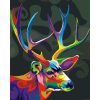
The Origins of Paint by Numbers
Paint by numbers, as we know it today, began its journey in the early 1950s. The idea was brought to life by Dan Robbins, a commercial artist working for the Palmer Paint Company in Detroit. With guidance from the company’s owner, Max S. Klein, Robbins set out to create a way for anyone—even those with no artistic background—to experience the joy of painting. In 1951, they released the first kits under the name “Craft Master.” These kits featured canvases with pre-printed outlines and numbered sections that matched specific paint colors. It was a simple yet brilliant concept that brought the world of art into everyday homes. Their motto said it all: “Every Man a Rembrandt.”
The Rise and Cultural Impact
Paint-by-numbers quickly became a cultural phenomenon in the 1950s. The kits’ simplicity and the satisfaction of completing a painting resonated with many, leading to widespread adoption across the United States. Sales soared, with over 12 million kits sold, and the trend extended beyond the U.S., influencing art and popular culture globally

Transition to Customization
Initially, paint-by-numbers kits featured generic designs such as landscapes and still lifes. However, as the hobby gained popularity, enthusiasts desired more personalized options. This demand led to the development of custom paint-by-numbers kits, allowing individuals to transform their own photographs into paintable artworks. These kits typically involve submitting a personal image, which is then converted into a numbered template, enabling hobbyists to create personalized masterpieces. This evolution not only enhanced the creative experience but also deepened the emotional connection to the artwork.


The Modern Era and Digital Integration
With advancements in digital technology, the process of creating custom paint-by-numbers kits has become more sophisticated. High-resolution images can now be easily transformed into detailed painting templates, and digital platforms allow users to design and order their custom kits online. This integration of technology has revitalized the hobby, attracting a new generation of artists and crafters seeking personalized and meaningful creative outlets.





